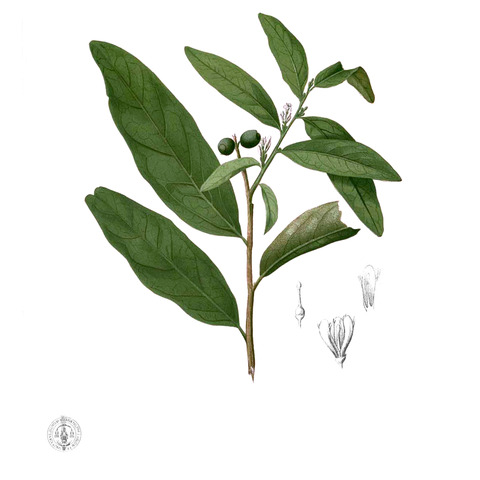Trees or shrubs, sometimes scrambling. Leaves alternate, simple, entire, exstipulate. Flowers bisexual or unisexual, actinomorphic (except sometimes stamens), solitary or in small bracteate umbels, racemes or clusters, axillary. Hypanthium often present (in Australian species). Calyx short, reduced to a rim or lobed. Corolla of 4-6 petals, connate or (not in Australia) free; lobes valvate, usually with a ±uncinate apical thickening inside. Disc absent or present. Stamens 3, 6 or 7, inserted in corolla tube; anthers basifixed, opening by 2 longitudinal slits; staminodes 5 or absent. Style simple; stigma globular, often shortly lobed; ovary superior or half-inferior, 1-4-locular; ovules 1 per locule, pendulous. Unisexual flowers with either stamens or pistil reduced. Fruit a 1-seeded drupe. Seeds with endosperm.
Ovary superior or slightly immersed in the disk, 1–3-celled; style 1, with a 2–5-lobed stigma; ovules 1–5 from the apex of a central placenta in a 1-celled ovary, or pendulous from the inner angle of a 2-or more-celled ovary
Ovary free or more or less immersed, usually 3–5-locular at the base or nearly to the apex; style short, columnar; stigma capitate, sometimes lobulate; ovules (2) 3–5, pendulous from the apex of a central placenta
Stamens free or rarely united into a column, the same number as and opposite the petals or fewer or more numerous, some often without anthers; anthers 2-celled, opening by slits or pore-like slits
Stamens as many as or more numerous than the petals, free or with the filaments more or less adnate to the petals, all fertile or some sterile
Calyx cupuliform, often accrescent, with the base free or more or less adnate to the ovary, and the margin entire or lobed
Fruit drupaceous, sometimes inferior by accrescence of the calyx or receptacle
Flowers actinomorphic, bisexual, in axillary fascicles, cymes or racemes
Seeds with copious endosperm and small or medium-sized straight embryo
Seed with abundant fleshy endosperm; embryo minute, apical
Petals 3–5 (6), valvate in bud, sometimes connate in pairs
Leaves alternate, simple, entire, penninerved, exstipulate
Flowers actinomorphic, usually hermaphrodite and small
Trees or shrubs, sometimes armed with spines
Petals free or variously connate, valvate
Leaves alternate, simple; stipules absent
Fruit drupaceous, ellipsoid to globose
Calyx-lobes imbricate or open in bud
Disk often present, usually annular
Disk present or inconspicuous
Trees, shrubs or climbers

